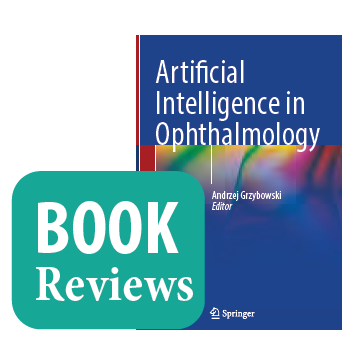Publication: Artificial Intelligence In Ophthalmology
Editor: Andrzej Grzybowski
Published by: Springer
Conjuring up all sorts of associations, from self-driving cars to the Wachowskis’ bloodthirsty robot overlords of The Matrix, Artificial Intelligence as a topic is at once fascinating and intimidating. But AI is not a nebulous concept. As you go about your day, AI is targeting advertising, filtering emails, and labelling pictures on the phone in your pocket, whether you are aware of its activities or not. It is difficult to know where to start when trying to understand how AI is likely to change clinical practice in ophthalmology, now and into the future. This vast and increasingly important topic is tackled in Artificial Intelligence in Ophthalmology, (Springer) edited by Andrzej Grzybowski MD, PhD.
The text, available in book and digital form, is aimed at a general audience and is accessible for ophthalmologists with no need for a background in computer programming. Beginning with an introduction that discusses the “Promises, Hazards, and Challenges” of AI in ophthalmology, the reader is brought right back to the first descriptions of the central components of AI in the 1940s, through to the exponential growth in research and applications of AI in the current COVID-19 era. Further chapters move on to the basic systems of AI, their various applications in eyes, and major topics of safety and trust, as we increasingly move from assistive to autonomous AI.
The book also introduces technical aspects of deep learning (DL)—an important type of machine learning and itself a field of AI. It highlights the performance of DL tools, which are at a sufficiently high standard to bring AI into the clinic. IDx- DR, a deep learning-based software that identifies referable diabetic retinopathy from fundus photographs, is the first FDA-approved AI application in ophthalmology. The Convolutional Neural Network (CNN) is described, among other forms of DL. The architecture of the CNN is intriguingly likened to the structure of the visual cortex, as both are composed of layers of nodes (or neurons) which feedforward from input to eventual classifying output; simple cells respond to lines, and complex cells respond to location-invariant patterns.
Further chapters focus on a wide range of applications of AI across different sub-specialties, from cornea to retina. They include problems such as age-related macular degeneration, glaucoma, retinopathy of prematurity, diabetic retinopathy, and keratoconus. Diabetic retinopathy screening emerges as an important success story in AI. The book also covers diagnostic applications in ocular oncology and neuro-ophthalmology.
Cataract and refractive surgery get special attention, including AI applications such as screening for keratectasia prior to laser refractive surgery, improving accuracy in IOL biometry calculations, and incorporating AI into cataract surgery training.
In the context of increasing desire and need for telemedicine, the promises of AI are balanced throughout the text by potential challenges such as medicolegal and ethical issues. Elon Musk tweeted in 2021, “There is also the existential threat of AI, which we should aspire to mitigate.” For ophthalmologists, it seems we do not face an existential threat yet; Grzybowski’s text reveals the myriad benefits that AI tools may add to our practice.


